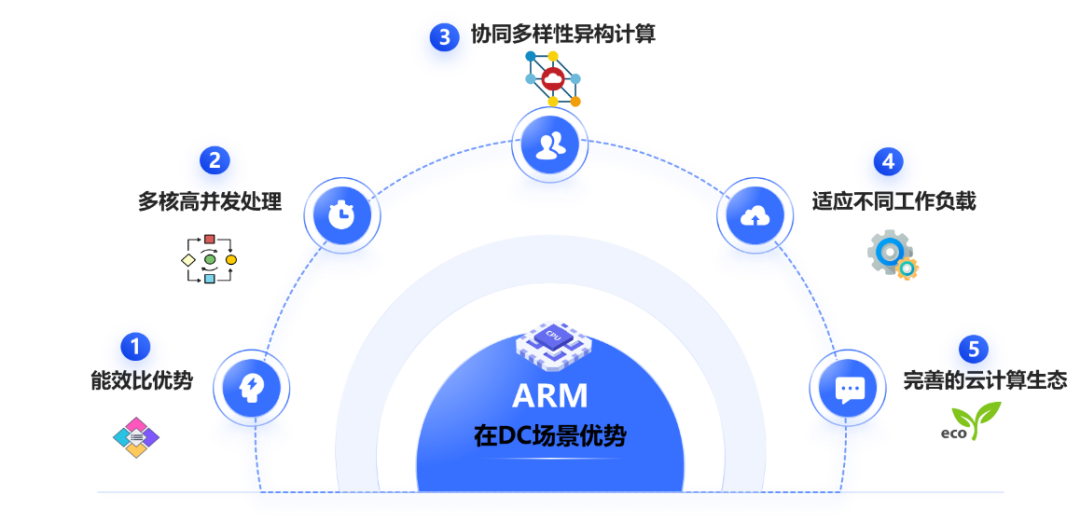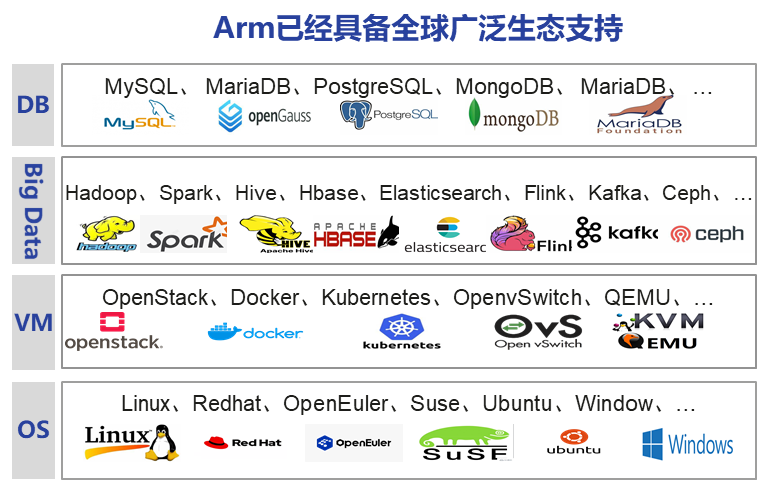11 1111
Join us now and sail into the technical blue ocean with global computing experts!
With the rapid development of cloud computing and artificial intelligence, data centers require more flexible, efficient, and cost-effective processors to support diverse computing tasks. At the same time, governments around the world are vigorously promoting green computing and sustainable development, raising higher demands for energy efficiency in data centers. The ARM architecture, with its advantages of low power consumption, high energy efficiency, and scalability, has become an ideal choice.
For a long time, data centers have been the “main battlefield” for X86 CPUs. In recent years, as computing scenarios have become increasingly diverse, the ARM architecture has successfully expanded from its initial mobile computing scenarios into the data center field. Today, ARM architecture CPUs are being applied in more and more data center scenarios, with major cloud service providers (such as AWS, Google, Alibaba Cloud, and Huawei Cloud) and innovative government and enterprise users deploying ARM-based computing infrastructure to reduce costs and increase efficiency, achieving significant benefits and demonstrating the immense potential and value of ARM architecture in the data center domain.

From a global perspective, ARM architecture CPUs have already achieved large-scale application in the data center field. According to predictions from several well-known consulting firms, by 2025, the penetration rate of ARM architecture CPUs in data centers will reach 20-25%, with a compound annual growth rate of 40% over the past few years, making it the fastest-growing force in the data center sector; Amazon’s self-developed ARM processors (Graviton series) have already accounted for 50% of its new computing power. These data indicate the success of ARM architecture in the commercialization of data centers.

Technological Innovations of ARM Architecture in Data Centers
The breakthroughs of ARM architecture CPUs in data centers are attributed to their outstanding advantages in performance, energy efficiency ratio, and TCO (Total Cost of Ownership). ARM processors significantly enhance computing performance and parallel processing capabilities through multi-core design, advanced process technology, and optimized instruction set architecture (SVE2/SME); by adopting a Reduced Instruction Set Computing (RISC) design, combined with Dynamic Voltage and Frequency Scaling (DVFS), their power consumption is significantly lower than that of traditional x86 architectures at the same performance level; additionally, ARM demonstrates clear TCO advantages through heterogeneous computing collaboration, intelligent workload management, and ecosystem synergy. These technological advantages enable ARM architecture to exhibit strong competitiveness in the diverse computing data center field, reshaping the competitive landscape of the data center market.

(1)Low power consumption and high cost-performance advantages of ARM architecture. This is mainly due to its RISC-based design, which simplifies the instruction set and optimizes the pipeline, greatly improving instruction execution efficiency and significantly reducing power consumption, thereby effectively lowering the electricity and cooling costs of data centers. Taking the AWS Graviton series processors as an example, through deep optimization, they achieve up to a 40% improvement in performance-to-power ratio compared to traditional X86 solutions, significantly reducing operational costs.
(2)ARM architecture brings TCO advantages to cloud computing with its inherent multi-core and high concurrency processing capabilities. ARM architecture’s multi-core parallel processing is suitable for handling high-concurrency tasks, particularly in lightweight virtualization and distributed computing scenarios. Advanced ARM processors often have dozens or even hundreds of cores, efficiently meeting the high concurrency and multi-tenant workload demands in cloud computing scenarios. In virtualized environments, ARM’s multi-core architecture can allocate computing resources more efficiently through fine-grained resource scheduling, increasing virtual machine density and thus reducing the overall hardware costs for cloud service providers. In cloud-native services such as containerization and microservices, ARM servers can support higher computing density with lower energy consumption, thereby creating more benefits.
(3)ARM architecture CPUs collaborate with diverse heterogeneous computing hardware to adapt to different accelerated computing needs. NVIDIA’s BlackWell accelerated computing platform (CPU+GPU) achieves efficient collaboration between CPU and GPU through flexible architectural design (unified memory access architecture and high-speed low-latency bus, etc.), reasonably allocating different types of computing tasks through a hybrid computing architecture, significantly enhancing the energy efficiency ratio and performance of the overall accelerated computing platform. For example, by combining the Grace CPU (ARM architecture) with the Blackwell GPU, NVIDIA GB200 significantly improves AI training and inference performance.
(4)ARM architecture can adapt to different workloads, showing significant advantages in mobile computing. The characteristics of ARM architecture enable it to flexibly adapt to computing demands from mobile devices to data centers, from edge computing to AI inference. With the increasing demand for cloudification of mobile applications, ARM architecture servers are natively compatible with mobile applications, ensuring rapid and smooth migration of applications to the cloud, and then achieving high-density deployment of multi-user instances through virtualization, significantly reducing the development and deployment costs of mobile applications. With a vast number of mobile devices adopting ARM architecture, the need for computing collaboration and data collaboration clearly makes ARM architecture more competitive on the data center side.
(5)More and more IT vendors support the ARM ecosystem, accelerating its improvement. Leading cloud vendors are launching various innovative practices based on ARM architecture: Google Cloud optimizes cloud services based on Ampere processors; Alibaba Cloud achieves performance breakthroughs with the Yitian 710 chip; in terms of the ARM software ecosystem, major IT companies are actively promoting deep adaptation and optimization of foundational software (Linux, databases, etc.) and cloud computing software (Docker, Kubernetes) for ARM architecture, accelerating the maturity of the ARM ecosystem.

Looking Ahead
The prospects for ARM architecture in data center construction are very broad.
Although x86 will still dominate the high-performance computing field in the short term, with the continuous improvement of the ARM ecosystem and the iterative evolution of its technical architecture, coupled with the inherent advantages of ARM architecture in data centers, user acceptance of ARM architecture is also increasing. It is expected that more government and enterprise users will deploy ARM architecture CPUs in data center construction in the future, and the penetration rate of ARM architecture in the data center market will continue to rise.
Welcome to reprint! Please contact us via WeChat for authorization confirmation before reprinting. When reprinting, the original source must be indicated. If prior contact is not made, please ensure that the content remains consistent with the original; if there are substantial differences or misleading statements, GCC and the author of this article reserve the right to pursue legal action.

11 1111
CompuWave flagship invites you to explore the computing stars and seas together!
Welcome to participate!
Join us in breaking the waves
and colliding ideas with global experts
to gain wider recognition for exciting viewpoints in the technical field!
If you want to share your technical insights, industry observations, and trend analyses in CompuWave,
please scan the code to contact GCC!
Now, join CompuWave
and sail into the technical blue ocean with global computing experts
👇

Teacher Ju

Teacher Hu
Like this post

Share this post

Like this post

Share this post